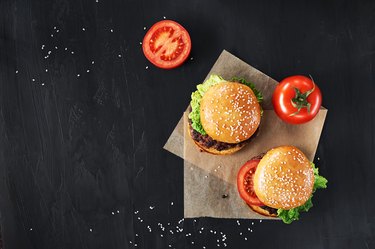
Grilled burgers are a staple of summertime barbecues, but it's not always convenient or possible to heat up the grill. Luckily, it's easy to cook a juicy, tasty burger on the stove inside — as long as you know how to properly and safely make a pan-fry burger.
Prepare the Burger Patties
Video of the Day
Everyone has their favorite recipe for a burger, whether it uses beef, turkey, pork or a combination of any of those proteins. Chef Frank Proto, the Director of Culinary Operations at the Institute of Culinary Education, uses 1 1/2 pounds of boneless short ribs — because of the high fat content that makes a juicy burger — that have been ground at home and shaped into four patties, then seasoned with salt and pepper.
Video of the Day
If you want a lower-fat option for your burger, Consumer Reports recommends blending lean beef — which dries out more quickly than high-fat options — with sautéed or roasted mushrooms and onions or cooked cracked bulgur wheat. The vegetables and grains help keep the burger both lean and moist.
Heat a Cast Iron Pan
While you can cook the burgers in any flat-bottomed pan, Proto's recipe uses a cast-iron skillet. A burger recipe by legendary American cook James Beard of the James Beard Foundation also calls for a heavy skillet in which you should first heat vegetable oil and salted butter. When the fats are melted and the pan is quite hot, you're ready to pan-fry the burgers.
Evenly space the burger patties in the hot pan. If your patties are about 1 1/2 inches thick, it will take approximately 5 minutes per side to cook them rare. The James Beard recipe states to only flip the burgers once, and not to press down on the patties while cooking. This can result in a dry burger, Chef Howie Velie, Associate Dean of Specializations at the Culinary Institute of America, told Consumer Reports.
Check the Temperature
Once the burgers look brown on the exterior, start checking the internal temperature with a meat thermometer. Use a digital thermometer, rather than a dial-based one — they aren't as accurate, according to North Carolina State University. Keep in mind that, while they may be tasty, rare or medium-done burgers aren't necessarily safe, particularly for children, older adults or those with a compromised immune system.
The US Department of Health & Human Services advises cooking beef burgers, as well as pork, veal or lamb burgers, to 160 degrees Fahrenheit to reduce the risk of E. coli and Salmonella. Be sure to check the internal temperature with a food thermometer early because you don't want it to go over 165 degrees Fahrenheit. This will result in a dry, tasteless burger. If you're making turkey or chicken burgers, you should cook them to an internal temperature of 165 degrees Fahrenheit.
James Beard's burger recipe recommends letting the burger patties rest for three to four minutes before serving. During this time, prep the toppings for your burger, which might include lettuce, tomatoes, onions, avocado, pickles, ketchup, mustard and, of course, buns. Make the bun a whole-grain option to increase the fiber content in your meal, and don't shy away from piling vegetables on top of that burger patty.
- U.S. Department of Health & Human Services: "Safe Minimum Cooking Temperatures Charts"
- Consumer Reports: "We Tried It: 4 Ways To Cook A Burger That’s Safe To Eat But Doesn’t Taste Like Leather"
- James Beard Foundation: "James Beard's Favorite Hamburger"
- Institute of Culinary Education: "Chef Frank Proto's Pro Burger"
- North Carolina State University: "5 Things You Should Know About Grilling Burgers (To Avoid Getting Sick)"
- Consumer Reports: "Yes, There Is Such a Thing as a Healthy Burger and Here's How to Build It"